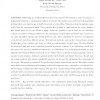88 search results - page 16 / 18 » Social navigation: modeling, simulation, and experimentation |
ICRA
2005
IEEE
14 years 1 months ago
2005
IEEE
— A new distributed coordination algorithm for multi-vehicle systems is presented in this paper. The algorithm combines a particular choice of navigation function with Voronoi pa...
ICMI
2003
Springer
14 years 20 days ago
2003
Springer
Many user interfaces, from graphic design programs to navigation aids in cars, share a virtual space with the user. Such applications are often ideal candidates for speech interfa...
SIGMOD
2008
ACM
14 years 7 months ago
2008
ACM
Graphs are widely used to model real world objects and their relationships, and large graph datasets are common in many application domains. To understand the underlying character...
CSDA
2011
13 years 2 months ago
2011
Estimating an overall density function from repeated observations on each of a sample of independent subjects or experimental units is of interest. An example is provided by biodem...
ECAI
2006
Springer
13 years 11 months ago
2006
Springer
Abstract. Computational Game Theory is a way to study and evaluate behaviors using game theory models, via agent-based computer simulations. One of the most known example of this a...

